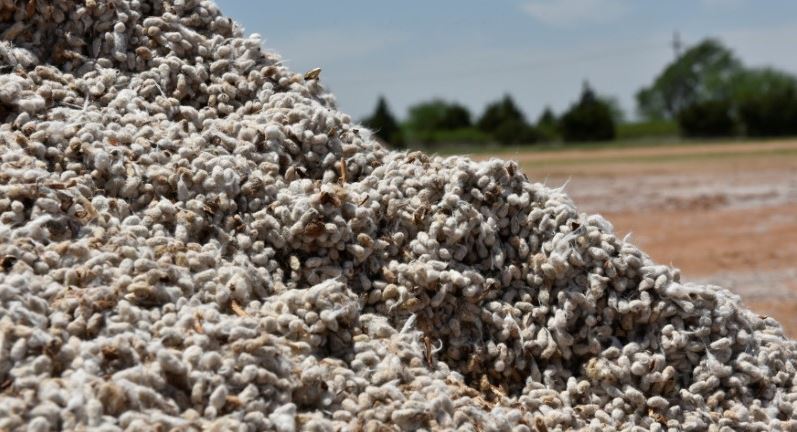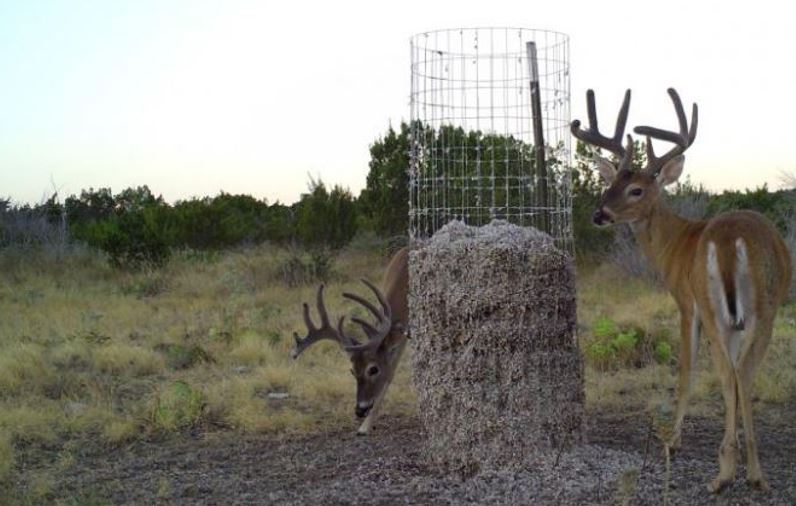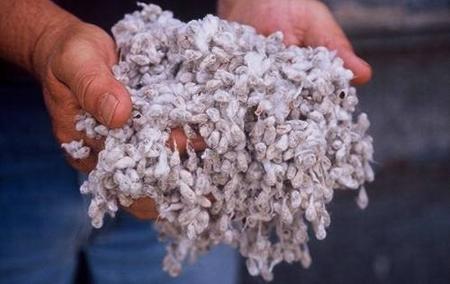Cottonseed for Deer
A big part of deer management is ensuring the physical health of individual white-tailed deer. Supplemental foods can help, but is cottonseed for deer a good idea? Possibly, as healthy deer makes for a healthy deer herd. Individual deer health is important for maintaining body mass, promoting maximum antler growth in bucks, and optimal milk production in does. Furthermore, healthy does means better annual fawn survival.
The energy and protein requirements of deer have become more understood over the years. Consequently, deer managers now focus much of their attention on meeting and exceeding the food requirements of white-tailed deer. This can be done in either of two ways. The first is through native habitat improvement. The second is by providing supplemental food. In some areas, feeding cottonseed for deer is an option that should be considered.
Feeding Cottonseed to Deer
Pelleted protein ranges from 14-24 percent protein and is readily available throughout the whitetail’s range. Protein pellets are commonly offered in free-choice feeders for deer. Most managers use a pellet that provides 16-20 percent protein. Pellets are super easy to use. However, costs is always a factor and managers often consider other sources of protein for deer diet supplementation. Several sources of “alternative” protein include crop seeds such as whole cottonseed and soybeans. Let’s discuss cottonseed for deer.
In some areas, cottonseed is readily available and a real option for managers. However, cottonseed contains a compound known as gossypol. This is a toxic pigment that the plant naturally produces. It’s believed that gossypol discourages consumption of the seed by animals. I’m probably not making a case for feeding cottonseed to deer at this point, but wait, there’s more.
Furthermore, gossypol can reduce reproductive ability in some mammals when consumed at high rates. Okay, so stick a fork in cottonseed? Nope, it’s not done yet! Fortunately, recent research in Texas has found that white-tailed bucks are not negatively effected by whole cottonseed, even when it makes up a high percentage of a deer’s diet. Yes, I’m saying there’s a chance.
Cottonseed Research
“We’ve done a series of independent projects,” said David Hewitt, the institute’s Stuart W. Stedman Chair for White-tailed Deer research. “In fact, we had five bucks on a 40-percent whole cottonseed diet and five bucks on pellets and chopped alfalfa from June through September. We looked at body weight, semen samples, and blood. We did not see any negative effects the first year.
The bucks on 40-percent whole cottonseed did lose some weight while the other bucks (on pellets and alfalfa) did not. Again, there were no toxic effects on the sperm or red blood cells. The bucks maintained their weight while the control group bucks gained weight. The doe weights did not change.”

Cottonseed by the Numbers
At over 22 percent crude protein, cottonseed is a high-protein food alternative that is also rich in phosphorus. This is great news, as phosphorus is one of the most limited nutrients in native forages. Phosphorus is important for body growth as well as antler growth in bucks. In addition to white-tailed deer performing well on cottonseed, there are some other positives surrounding the feeding of whole cottonseed.
Non-target species, such as feral hogs, raccoons and other varmints do not eat whole cottonseed. Furthermore, these animals do not even have to be excluded from cottonseed feeders. They simply will not use cottonseed as part of their diets. This helps the bottom line by limiting consumption by animals other than the target species, whitetail deer. As we all know, a decent percentage of pellets is lost in waste, to both the weather and non-target wildlife.
Whole Cottonseed for Deer
All in all, cottonseed is a solid choice as a supplement for whitetail because it’s high in protein, high in fat, and it does not easily degrade under moist conditions. In fact, it does not get any easier than feeding cottonseed to deer. You can simply place cottonseed out on the ground or in a free-choice feeder. Standard whole cottonseed is not the only game in town. There is also a slightly modified product called EasiFlo, and it has some advantages.
EasiFlo cottonseed has the same nutritional benefits as regular (fuzzy) whole cottonseed, but is starch-coated to improve handling. This new cottonseed flows freely and can easily be augered through traditional grain-handling equipment. This choice really does make feeding cottonseed for deer easy. It also increases the options for the deer manager and hunter.

Cottonseed for Bucks
Whole cottonseed as a supplemental food for deer is great for maintaining the physical health of a herd. It is especially effective for improving the body condition of bucks following the rut. Because cottonseed is high in protein and fat it allows post-rut bucks to put weight back on rapidly, meaning more energy is reserved for antler growth. Following the end of the breeding season, new antler growth kicks off just a few months later. You do not want bucks struggling to put on weight at that time.
Feeding cottonseed will increase deer body condition, help improve annual fawn production and allow for increased antler development in bucks. However, cottonseed as a feed it should not be considered a complete ration for white-tailed deer. It’s not a one-stop-shop, but whole cottonseed is still a good supplement for whitetail. What is makes up in protein and fat it lacks in some nutrients.
Sizing Up Cottonseed for Deer
Whole cottonseed lacks many of the micro- and macro-nutrients that protein pellets contain. After all, pellets are developed to serve as a complete ration/diet for deer. However, cottonseed fits the bill for free-ranging deer in good habitat. Whitetail will pick up other necessary nutrients from other aspects of their diet. Although cottonseed has many great qualities, its availability may be limited in your area. This is the primary reason why more managers do not use cottonseed for deer.
Remember, regardless of whether you decide to supplement a deer herd through protein pellets, crop seeds or food plots, supplements are only intended to compliment native forage. Supplementation is most important during periods of stress. With this in mind, cottonseed is well suited to serve as a true supplement for deer. If it’s available in your area, cottonseed for deer is a good idea, especially after the rut in late-winter.

I see the relation in the bottom line , the dime . It would be interesting to see the local stores pic up cotton seed as a whole . But we dont see it through pushing the pelleted feed. Its not cost effective on the other end. Good point though on not feeding the coons or pigs . I know we have some of the biggest coons around.
Good article
What happens when the cotton seed gets wet? I find that open range deer have a hard time with anything with a top, such as a feeder with a top.
How much space does cotton seed take up? How many pounds would fit in a trailer that is 6 ft. x 16 ft. with 4 ft. side walls?
Mike, I want to say that cottonseed weighs about 28 pounds per cubic foot, so your trailer would hold between 8,000 and 10,000 pounds depending upon the quality (how clean the seed is) of the cottonseed. Also, cottonseed is not effected by water.
Buck Manager is right on target (32lbs). Cottonseed is a very interesting creature. Do we find cottonseed having problems in deer as we do with feeding to much to bulls?
Travis, yes cottonseed can cause sterility in whitetail bucks, as in any mammal. It is okay to feed deer cottonseed during the spring through July, but cut them off it as the breeding season approaches.
Does anyone know where I can find whole cotton seed in Texas? Our ranch is in Ozona, but Abilene, San Angelo, etc., would be acceptable. Thanks.
Cotton seed meal is pretty easy to get your hands on through your local feed store. The draw back to this is that it’s not in the seed form. We feed the meal in troughs. Regulations to my understanding have made this product (cotton seed a little harder to find, just like soy beans.
In central Texas and parts of the south, I have found my best chance is to either call the gin directly or our farmer places an order for it when he takes his cotton in to be de-linted. Going through a farmer seems to have a better price since it is their cotton and they are usually in a co-op.
If your lucky you may find some left at a feed mill out that way, but like I said if your lucky. Most of the cotton seed goes quick to the larger mills were it is ground up to make cotton seed mill or sold whole to the large feed lots. The best time to get it is during the cotton gining process usually around late October early November. The best place to get it is directly from a gin were it will cost you little bit less than $200 a ton, once it leaves there the price goes up
I’ve heard and read a great deal about cottonseed, but I’m not 100% sold on it. I’m sure it produces results, but is there a study that compares feeding cottonseed and mineral supplement on the ground versus 16 to 20% protein feed that already has minerals within it (in the same range and similar genetics of course). I guess it could be fed as a supplement to protein feed, but that can get expensive really quick. We ALREADY spend more on feeding the deer than we do ourselves.
I have looked and called anyone I can find around Wharton, Rosenberg, and the south Houston area and all I can find is buying it in supersacks. I can’t handle it that way. Does anyone in the expanded Houston Area sell it in lesser packed quantities. I don’t mind buying a ton, but I can’t handle a supersack. By the way the price for a ton in supersack was quoted at $150.
You can get 50 lb bags of cottonseed from Johnson and Sons in Elgin, TX. The phone number is 512-285-2462 and I think it’s cost about $9 a bag.
Thanks Jay, I’m just down the road from there. I can’t seem to find it in anything but bulk in Taylor.
I have been feeding cottonseed the past two years. If you decide to try this there are a few things to keep in mind. When building a feeder, it must be open on all sides and only be about 32 inches off the ground. The other thing is to mix it with a little corn and other proteins to get them to start using it. Gradually reduce the corn and/or protein pellets until you are feeding just pure cottonseed. We are seeing good results on our ranch and folks around us that are doing the same are seeing them as well.
Where did you find the super sacks for $150 per ton? Could you please provide the phone number?
I know Damon Feed (between Needville and West Columbia near the coast) had the whole cottonseed… not sure of pricing or quantities. Possibly could check with Danevang Farmers Coop south of El Campo as well.
I have some pics of an easy to build feeder that a friend of mine uses for cottonseed. The pics will speak for themselves as to effectiveness. He has been feeding it for 3 years to free ranging deer in Brazoria and Matagorda counties and loves the results. We are planning to start feeding it on our lease in the hill country this year. If anyone wants to see pics, email me at txsaggie94@windstream.net with cottonseed feeder in the subject line.
You will be getting about 1 1/2 tons on that trailer. Put some out now to get them through winter, but save some for april and may for horn development.
I am just starting to introduce the cotton seed to my native free ranging deer. I was just wandering about the overall fertility of the bucks. Do they become less fertile eating cottonseed? Can someone recommend the months to place it in troughs? Thanks
Jaime, you can start feeding cottonseed after the rut and throughout most of the year. Cottonseed contains a compound called gossypol that can make most mammals sterile when ingested in high amounts, but fortunately that reverses once animals quit consuming it. To make sure there are no infertility issues with the bucks on your property, make sure the cottonseed is gone at least 6 weeks before the breeding season.
We have started feeding this on our lease along with protein in western Nueces County. For now we are placing it in feeder pens along side our protein feeders.
The deer love this stuff and actually prefer it over the protein. But, we do have some bucks that will not enter our pens even at 60′ diameter wise. My question is if we decide to put this out of the feeder pens in certain spots of the ranch where we have seen good quality young deer I’m sure cows will consume some of it. Will this effect the fertility of the live stock on the ranch. Not sure if putting a barbed wire type pen will deter the bucks from entering them as well.
Jaime, cattle will definitely go for cottonseed. If cows are present then I would not recommend putting up a feeder unless you can fence out the cows. They love cottonseed and will eat a heck of a lot more each day than a deer.
As for bucks not entering your feed pens, it could be the result of wary deer or the fact that more dominant bucks are in the area (so the satellite bucks avoid the feeders) to avoid head-to-head (literally) competition.
Are cottonseed hulls the same as whole cottonseed? I have found cottonseed hulls in pound bags, just wanted to make sure that it was the same?
James, hulls are not the same as whole cottonseed. Mostly used for livestock. Cottonseed hulls are low in protein, calcium, phosphorus and energy and high in fiber. Cottonseed hulls are palatable and are used as a roughage for cattle where good quality forages are scarce. They occasionally are included in grain mixes to increase the bulk density and crude fiber content.
Pellets made from 100% cottonseed with high natural oil left in feed has been feed to cattle and deer for years. Can get it with corn added to make a 20 % hi-protein feed pellet also available. Made in Roaring Springs, Texas since 1997. These pellets are very high in natural phoshorus and help bucks put on a lot of antler.
Campbell, thanks for giving those that manage property or deer hunt in the southern panhandle and northern big country a good source for pellets. Phosphorus is important for deer for sure and cottonseed oil really helps keep deer in good condition.
How early in the year can you start feeding cottonseed to whitetail deer?
Jack, you can start feeding whole cottonseed as soon as you are finished hunting for the year. It’s a good food following the breeding season because cottonseed helps put weight back on deer, especially since natural foods are in short supply during this time of year. It can be feed throughout the entirety of the year, but I’d stop about 6-8 weeks before the rut typically occurs in the area. The odds of causing any sterility issues in bucks is very low, but better safe than sorry, right?
Anyone have a good source for the whole cottonseed in the Texarkana, TX area?
It looks like whole cottonseed has been used now for several years and I would like to know if any of the deer farmers use it and if so, do they know for certain that bucks became infertile? And if they did do they know how much cottonseed that buck consumed?